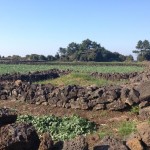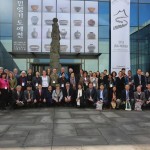
Cultural landscapes are often defined as geographic areas of natural and cultural resources with associated historical, cultural and or aesthetic values. One way to sharpen our focus on the components of a landscape is to experience the combination of these resources through a new lens. Jeju Island is a spectacular place to do this. Often referred to as the Hawaii of Korea, Jeju is a volcanic island 56 miles off the coast of the South Korean mainland. Some of the island’s most outstanding natural features have been designated as the country’s only natural world heritage listing, otherwise known as the Jeju Volcanic Island and Lava Tubes (2007).

The island’s cultural landscapes, although not yet listed, are also very distinctive. For centuries residents have carved fields out of the rocky soil creating thousands of kilometers of still extant stonewalls. The underlying basalt was also used for clusters of farmhouses in villages around the island and for massive fortifications to protect it’s shores. The sea has always been an important part of the region’s life. Today, Jeju has been discovered as a tourist destination for the beaches, the natural wonders, and more recently the rural landscape. Over 10 million tourists visit Jeju a year, which for an island with a population of 600,000, places a lot of stress on the limited resource base. A recent initiative strives to spread the visitors around through the development of walking trails known as Olles. These well maintained trails direct visitors both along the coast and also off the beaten path to scenic overlooks and into traditional villages and agricultural areas through the use of signs.

Haenyo Museum Jeju Island
This island of scenic beauty, rich heritage and future opportunities, offered a remarkable setting for the November 2015 Annual Meeting of the ICOMOS-IFLA International Scientific Committee on Cultural Landscapes (ISCCL). A meeting at which the conversation centered around the aesthetics of landscapes, connecting the practice of nature and cultural conservation, and an initiative to advance the understanding and conservation of world rural landscapes . The setting for the gathering could not have been more appropriate–it was held overlooking the water at the Haenyo Museum, a facility dedicated to telling the story of the islands’ famous women divers. The mingling of historical, cultural, and natural resources and memories evoked a powerful sense of place and support for conserving more sites such as this.

Jeju Stone Park
An international Symposium Re-thinking Lifescape: Linking Landscape to Everyday Life followed on the committee meeting and attracted over 200 participants. While many were from the Pacific Rim countries, there were also presenters from all over the globe. It was particularly encouraging to see so many excellent papers on cultural landscapes by graduate students and young professionals. The symposium was held at the famous Jeju Stone Park on the slopes of the island’s huge shield volcano, Mount Hallasan. Attendees were offered a number of tours of the key sites on the island including two of the world heritage sites: the Manjanggul Lava Tubes and Seongsan Peak. Both events were organized by the hard work of ICOMOS-Korea with special thanks to Professor Jongsang Sung the head of the Korean ISCCL, the many sponsors he attracted for the event, and of course, his hard working students.
Does this sound like an amazing opportunity to learn more about cultural landscapes? For those with an interest in placing cultural landscapes in an international context consider these upcoming events in 2016: The World Conservation Congress (WCC) meeting, and the conference Capability Brown: perception and response in a global context. The WCC will be meeting in Hawaii in early September 2016 where congress planners will consider a range of sessions that explore the connection between cultural and natural resources. In the same month, on the other side of the globe, ICOMOS UK will hold the capability conference in Bath. The conference celebrates the tercentenary of Capability Brown’s (Lancelot Brown) birth with an opportunity to reflect on his work in an international context.
If you are in the United States, or even if you are not, consider joining US ICOMOS. Support our international mission and stay informed about cultural landscape work at a global scope. This topic will be a focus of the organization’s new initiative for 2016 known as the Cultural Landscape Knowledge Exchange.
Finally, US ICOMOS is launching a National Committee on Cultural Landscapes. We plan to have gatherings at selected upcoming conferences to share information and build a community of practitioners. If you are interested in getting on the list, please email me at bbarrett@livinglandscapeobserver.net or our US ICOMOS ISCCL voting member Nora Mitchell at norajmitchell@gmail.com.


